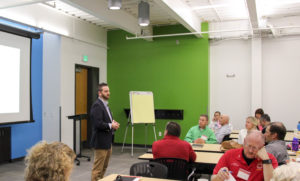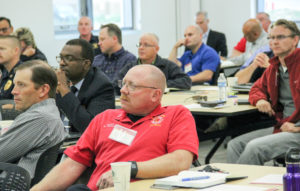CSU faculty member Tim Amidon recently organized an event to help members of the United States Fire Service adjust their mindset when it comes to firefighter safety.

The Adaptive Challenges Symposium was held at the Colorado State University Powerhouse Campus on Oct. 28. The purpose of the symposium was to emphasize firefighter safety as a bigger priority in the industry. The symposium focused on educating members of the U.S. Fire Service to have an adaptive mindset rather than a technical mindset when fighting fires. The event was hosted by the Poudre Fire Authority, and was facilitated by members of an interdisciplinary research team from CSU.
Amidon, an assistant professor of English at CSU, was the lead facilitator for the event. Amidon is a former firefighter and is currently a faculty affiliate for the Center for Disaster and Risk Analysis.
Amidon cultivated relationships with researchers in various departments on campus who are also interested in risk to collaborate on the research initiative.
“Adaptive challenges are interesting, and we want to work towards educating the fire service community,” said Amidon. “We want to encourage the community to engage in a dialogue with technical and adaptive solutions.”
High risk and human error
Firefighting has a higher risk factor than many other professions. Amidon focuses on the impact that human error can have in the profession.
“The human factor element tends to be undervalued, and we need to think deeply about the contributing factors,” said Amidon.
Situations such as a “mayday,” which is used as a distress signal when a firefighter is in a life-threatening situation, are sometimes considered the fault of the firefighter, instead of a factor of the human element. Situations are often handled incorrectly because of the lack of communication among crew members and the firefighters on-site. Miscommunication has proven to be a factor that has led to firefighter fatalities in dangerous situations. 
The symposium addressed the human dimension of fatalities and the fact that there is currently not a multidimensional way to understand firefighter fatalities. There have been 30 years of technological innovations regarding safety within the fire service, but the human element factor has not been addressed in situations that result in fatalities, Amidon said.
The culture of firefighting has often been seen as a blue-collar industry instead of a profession, he added.
“There seemed to be a blue-collar tradition of what firefighting has meant in the past,” Amidon said.
There are vocational firefighting schools that teach future members of the fire service the basics of the occupation. If more individuals in the fire service, as well as outside the service, considered firefighting to be a profession, there could be more educational training for the industry.
‘Empowering firefighters’
“It is important to empower firefighters at the entry levels to know how to do the knowledge work that is associated with the job,” Amidon said.
The event was interactive. Attendees were encouraged to discuss their opinions and past experiences in group settings, as well as in open discussions with the rest of the members of the symposium.
“This is an event to discuss current problems in hopes of future answers,” said Randy Callahan, battalion chief for the Poudre Fire Authority, who attended the symposium.
There were many fire service representatives at the symposium, from as far away as Oakland, California, and Canada, and as close as the Front Range.
“This symposium is for different stakeholders across the fire industry to discuss the human factor element,” said Amidon.
“It is exciting to have research involved in aspects of the fire service. This event is a mixture of diverse academia paired with the fire service,” Callahan said. “It is bringing together leaders from the fire service, private sector, government and academia.”
The Poudre Fire Authority and the research team at CSU are currently collaborating on several research projects.
“Research leads to education, which leads to extended training,” Callahan said.